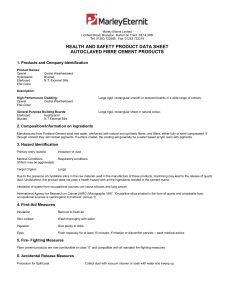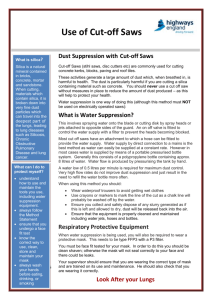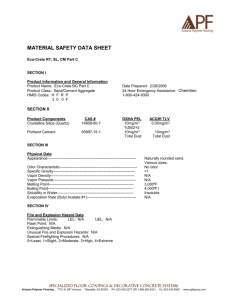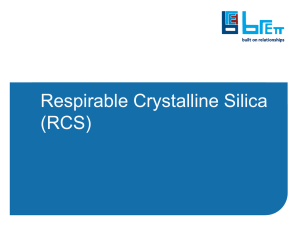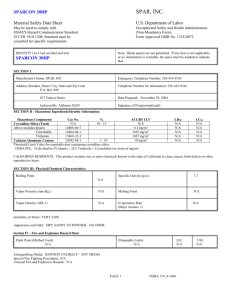Exposure control plan for cutting fibre cement
advertisement
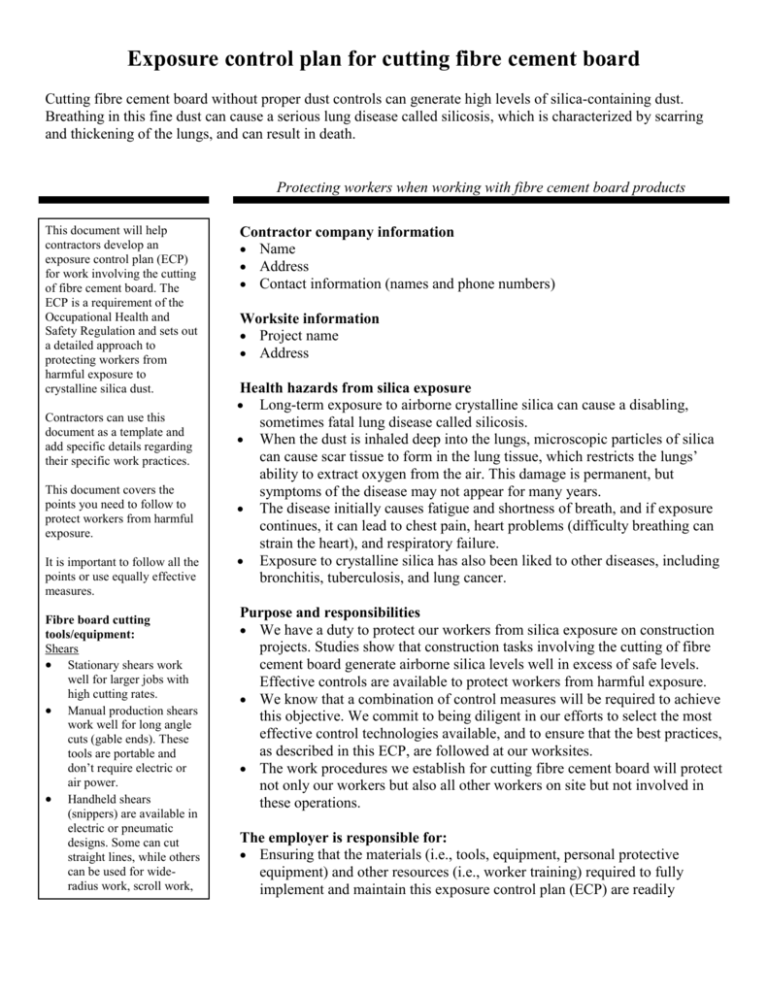
Exposure control plan for cutting fibre cement board Cutting fibre cement board without proper dust controls can generate high levels of silica-containing dust. Breathing in this fine dust can cause a serious lung disease called silicosis, which is characterized by scarring and thickening of the lungs, and can result in death. Protecting workers when working with fibre cement board products This document will help contractors develop an exposure control plan (ECP) for work involving the cutting of fibre cement board. The ECP is a requirement of the Occupational Health and Safety Regulation and sets out a detailed approach to protecting workers from harmful exposure to crystalline silica dust. Contractors can use this document as a template and add specific details regarding their specific work practices. This document covers the points you need to follow to protect workers from harmful exposure. It is important to follow all the points or use equally effective measures. Fibre board cutting tools/equipment: Shears Stationary shears work well for larger jobs with high cutting rates. Manual production shears work well for long angle cuts (gable ends). These tools are portable and don’t require electric or air power. Handheld shears (snippers) are available in electric or pneumatic designs. Some can cut straight lines, while others can be used for wideradius work, scroll work, Contractor company information Name Address Contact information (names and phone numbers) Worksite information Project name Address Health hazards from silica exposure Long-term exposure to airborne crystalline silica can cause a disabling, sometimes fatal lung disease called silicosis. When the dust is inhaled deep into the lungs, microscopic particles of silica can cause scar tissue to form in the lung tissue, which restricts the lungs’ ability to extract oxygen from the air. This damage is permanent, but symptoms of the disease may not appear for many years. The disease initially causes fatigue and shortness of breath, and if exposure continues, it can lead to chest pain, heart problems (difficulty breathing can strain the heart), and respiratory failure. Exposure to crystalline silica has also been liked to other diseases, including bronchitis, tuberculosis, and lung cancer. Purpose and responsibilities We have a duty to protect our workers from silica exposure on construction projects. Studies show that construction tasks involving the cutting of fibre cement board generate airborne silica levels well in excess of safe levels. Effective controls are available to protect workers from harmful exposure. We know that a combination of control measures will be required to achieve this objective. We commit to being diligent in our efforts to select the most effective control technologies available, and to ensure that the best practices, as described in this ECP, are followed at our worksites. The work procedures we establish for cutting fibre cement board will protect not only our workers but also all other workers on site but not involved in these operations. The employer is responsible for: Ensuring that the materials (i.e., tools, equipment, personal protective equipment) and other resources (i.e., worker training) required to fully implement and maintain this exposure control plan (ECP) are readily or circles. Shears can only cut one thickness of siding and can't cut 1.9 cm (3/4 in.) trim boards. For this, a circular saw works best. Circular saws A number of equipment manufacturers make saws specially designed for cutting fibre cement board. These tools are designed to stand up to abrasive silica dust and the dust loading generated during this type of work. For example, these tools have dust-proof bearings and a switch with a dust-proof casing. When saws are used, a dust collection system is required. Such a system includes an industrial vacuum cleaner designed for use with silica dust and equipped with a HEPA filtering system. These systems rely on attachments including shrouds (suction casings that surround the cutting blade), hose attachments, and vacuum cleaners. The dust is collected within the shroud and drawn into the vacuum, where it is filtered and discharged. Each tool has a different approach to collecting and/or controlling dust. Score & snap knife Used to scribe the back of the cement board and snap it over a 2X4. Cut this way, siding breaks cleanly, as long as you scribe it uniformly. Crews using this method can be as productive as crews using other cutting methods. available where and when they are required. Conducting a periodic review of the effectiveness of the ECP. This includes a review of available dust control technologies to ensure these are selected and used when practical. Ensuring that all required tools, equipment, and personal protective equipment are readily available and used as required by the ECP. Ensuring supervisors and workers are educated and trained to an acceptable level of competency. Maintaining records of training, fit-test results, crew talks, and inspections (equipment, PPE, work methods/practices). Coordinating the work with the prime contractor and other employers to ensure a safe work environment. Supervisors are responsible for: Providing adequate instruction to workers on the hazards associated with the cutting of fibre cement board. Selecting and implementing the appropriate control measures. Ensuring that workers using respirators have been properly fit-tested and that the results are recorded. Directing the work in a manner that ensures the risk to workers is minimized and adequately controlled. Liaising with the prime contractor and other subcontractors to ensure a safe work environment. Workers are responsible for: Using the assigned protective equipment in an effective and safe manner. Setting up the operation in accordance with the site-specific plan. Following established work procedures as directed by the supervisor. Reporting any unsafe conditions or acts to the supervisor. Knowing how to report exposure incidents. Risk identification and assessment Fibre cement board can contain up to 90% crystalline silica. Cutting fibre cement board without the use of proper dust controls and personal protective equipment can expose workers to airborne respirable crystalline silica levels above the exposure limit listed in the Occupational Health and Safety Regulation. Exposure limit The occupational exposure limit (OEL) for respirable crystalline (including quartz) is 0.025 milligrams per cubic metre (mg/m3). As crystalline silica is linked to lung cancer, the ALARA principle also applies, and workplace exposures will be reduced to levels as low as reasonably achievable. Silica dust control The Regulation requires employers to select silica dust controls based on the following hierarchy: o Substitution 2 o o o Engineering Administrative controls Personal protective equipment Use of respirators as a primary control is not acceptable when other methods are available and practical. Equipment tips Invest in good quality equipment and keep it well maintained. Well-designed and maintained equipment significantly reduces dust and lasts longer between replacement and maintenance. A variety of specially designed equipment is available for cutting fibre cement board. Respirator program Employers whose workers wear respirators are required to develop and implement a respirator protection program. The WorkSafeBC publication Breathe Safer provides guidance for developing this program. Additional information The following WorkSafeBC publications are available from WorkSafeBC.com. Breathe Safer booklet Toolbox Meeting Guides o Silica awareness o Silicosis o Silica safety when cutting fibre cement board For information about workplace health and safety, employers and workers can call the WorkSafeBC information line at 604 276-3100. Acceptable control methods for cutting fibre cement board WorkSafeBC has reviewed the various cutting methods available for fibre cement board and have determined that the methods that appear in the following table are acceptable, provided that the respirator selection is adhered to. The following control options will be used to eliminate or reduce the risk to workers from the hazards of silica dust exposure: Cutting method/tools Fibre cement shears Fibre cement shears Score and snap knife Dust-reducing circular saw connected to HEPA vacuum extraction Dust-reducing circular saw connected to HEPA vacuum extraction Work location Outdoors Indoors Outdoors or indoors Respirator type None required N95 respirator None required Outdoors Half-face or full-face respirator with N100 filters Indoors Half-face or full-face respirator with N100 filters Respiratory protective equipment Each worker will be fit-tested if a respirator is required. When the worker notices a notable resistance to breathing, the respirator filters must be replaced. Respirators will be used, cleaned, and stored in accordance with the respiratory protection program. Other personal protective equipment Workers will wear approved safety glasses and hearing protection when cutting cement board. Workers will wear washable work coveralls. Safe work planning Select one or more of the cutting methods described in the table above. Select a cutting location well away from active work areas. Inspect all dust control equipment/tools available on site to make sure they are in good working order. Use and maintain all tools as specified by the manufacturer. Review the safe workplan and work procedures with workers involved in cutting fibre cement board. 3 Establish a barrier around the cutting work zone to restrict access to unprotected workers. Provide the general contractor with a copy of the site’s silica exposure control plan and safe work procedures. Useful links HSE leaflets (silica and construction) can be downloaded free from the HSE web site: www.hse.gov.uk/pubns NIOSH publications are available at no charge at www.cdc.gov/niosh. Search 'silica' and 'construction'. Make sure that workers inspect their respirators before start-up. Monitor dust release from your equipment during cutting. When tools/equipment are working properly, very little dust should be visible in the air. Stop work if excessive dust is observed. Vacuum or wet wipe any settled dust from floors and work surfaces (do not use compressed air). Vacuums will need to be cleaned and the filters changed on a regular basis. Health surveillance Workers who are regularly exposed to silica dust will receive regular medical examinations from their family physicians. These examinations may include chest x-rays. Workers will report any symptoms of silica exposure for tracking and investigation. Workers will be trained in the following: The risk of exposure to silica, and the signs and symptoms of silica disease Safe work procedures to be followed Proper use of all required equipment and tools Proper use of respirators and other personal protective equipment How to seek first aid How to report an exposure to silica dust Annual review This ECP will be reviewed at least annually and updated as necessary by the employer, in consultation with the workplace health and safety committee or the worker health and safety representative. 4
